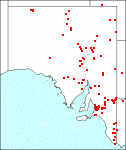Family: Haloragaceae
Myriophyllum verrucosum
Citation:
Lindley in T.L. Mitchell, J. Trop. Austral. 384 (1848).
Synonymy: M. variifolium Hook. f. var. microphyllum F. Muell. ex Sonder, Linnaea 28:234 (1856).
Common name: Red water-milfoil. (I11. Cochrane et al. (1980) Flowers and plants of Victoria and Tasmania 62, fig. 269; Orchard (1986) Brunonia 8:, fig. 7.)
Description:
Perennial aquatic herb, stems 0.1-1.5 m long; leaves dimorphic; submerged leaves in whorls of 3 or 4, orbicular, pectinate, 6-12 mm long, with 8-20 pinnae; emergent leaves in whorls of 3 or 4 (rarely 5), glaucous, green to reddish-purple, lanceolate to ovate, 3-9 mm long, lower ones pinnately lobed or dissected, upper ones entire.
Plants monoecious, flowers mainly unisexual, with a few transitional bisexual ones, all solitary in the axils; bracteoles straw-coloured, narrowly lanceolate or oblanceolate to ovate, 0.8-0.9 mm long, entire or 2- or 3-toothed; male flowers 4-merous, sessile; sepals yellowish, deltoid, 0.3-0.4 mm long; petals yellow, 1.7-2.5 mm long, hooded, caducous; stamens 8; ,anthers linear-oblong; styles absent; ovary vestigial; female flowers 4-merous, sessile; sepals deltoid, minute; petals vestigial; stamens 0; styles clavate, stigmas fimbriate; ovary orbicular, c. 0.6 mm long, 4-locular.
Fruit cubiform, straw-coloured, red or deep-grey; mericarps shortly cylindrical, 0.9-1.1 mm long, with irregular dorsal ridges and 2 lateral ridges, irregularly warty.
|
|
Distribution:
|
Widely distributed throughout drier and semi-arid areas in semipermanent bodies of water, and extending its range by colonising stock watering points. In calcareous waters plants are often lime-encrusted.
S.Aust.: NW, LE, GT, FR, EA, EP, NL, MU, SL, SE. W.Aust.; N.T.; Qld; N.S.W.; Vic.
|
Conservation status:
native
Flowering time: throughout the year.
|

SA Distribution Map based
on current data relating to
specimens held in the
State Herbarium of South Australia
|
Biology:
McBarron (1972) found that the HCN content of plants of this species varied from nil to high. In some places it is eaten avidly by stock, in others it is poisonous. Plants growing stranded on mud have small pinnatisect leaves and a stunted habit but are fertile. Those in deep fast flowing water remain sterile.
Author:
Not yet available
|

